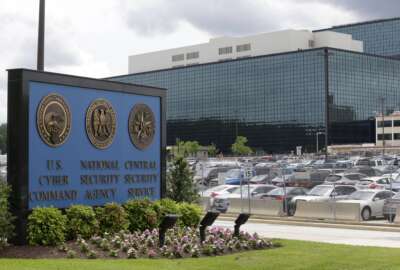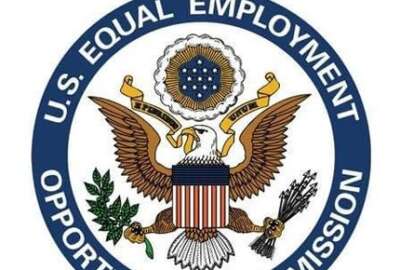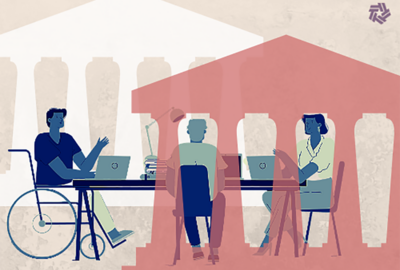NSA women leaders find opportunities to ‘drive change and mission’
Three women leaders at the NSA share their stories and highlight how the agency is aiming to become a better employer for everyone, including women.
Women make up about 40% of the intelligence community’s workforce, a percentage that ranks behind both federal workforce and civilian labor benchmarks.
That’s according to the latest demographics report from the Office of the Director of National Intelligence. And women are even more underrepresented in the leadership ranks throughout the IC.
But agencies aren’t ignoring the issue. The National Security Agency’s “Future Ready Workforce” initiative has already led to several changes that will likely make the NSA a more attractive employer for all employees, including women. And the NSA is also investing in education and other programs that encourage girls to get involved in STEM.
Inside the IC spoke with three women leaders at the NSA about the past, present and future for women at the agency. They are Morgan Adamski, chief of the NSA’s Cybersecurity Collaboration Center; Kristina Walter, director of the NSA’s Future Ready Workforce Initiative; and Tahira Mammen, acting chief of the AI Security Center, which is housed within the Cybersecurity Collaboration Center.
This interview transcript has been edited for length and clarity:
Justin Doubleday I’d love just to kick off by asking any of you to reflect on the role that women have played at NSA, historically, maybe some of the challenges and how we got to where we are today?
Kristina Walter I think the NSA is a unique space in that we do have a history of women being involved in the cryptologic mission. So we think of Elizabeth Friedman, and a lot of cryptographers that have contributed to the National Security Agency’s mission from World War Two, when we’re talking about codebreaking.
And so a lot of us can see that in the day to day. We have a lot of strong women leaders here. But I think we face the same challenges that any organization does, especially a predominantly military organization, where we’re still working through the balance of women being visible and at the table. And I think what we found is, we need to be inclusive of that environment. Women have a lot to offer in that space.
And so what systems can we put in place to just be inclusive of everybody’s thoughts and ideas and really bring that diverse perspective in? And so that’s really what we’re trying to achieve, as we move into this new era of rapidly evolving technology changes, rapid competition for talent that we haven’t had to face before. So how can we be really an attractive employer for all people, including women?
Justin Doubleday Morgan, there’s this overlap between the challenges that women face in the intelligence community but then also in the cybersecurity field. I think maybe the numbers are even worse writ large across the cybersecurity field.
Morgan Adamski There’s definitely a really strong focus right now on getting more women involved in cybersecurity, more women involved in STEM roles. And I think that’s really important. Just because when you have diverse opinions, diverse backgrounds, whether you’re male or female, they, however you want to describe yourself, it’s really important that we have those conversations. In cybersecurity, you need innovation and unique solutions to complex problems. And that means you have to approach that in many different ways. And so you have to have a lot of different people at the table to have that discussion.
Kristina talked about some of the things we’re doing at the agency in focusing on people. The cybersecurity community, and NSA historically, has been involved in strong technical backgrounds. That’s what we do here. And so the same challenges you see on getting more women in STEM is how we try to encourage and recruit more women in NSA. It has to go hand in hand.
Justin Doubleday Tahira, AI is one of the newer fields, depending on how you define it. Are you seeing any specific challenges in that field kind of pour over from maybe the legacy STEM challenges that we’ve seen? How are you confronting this as a woman in the AI field, a leader in the AI field?
Tahira Mammen I’ll start by saying that we have many brilliant women at NSA who are experts in AI. I think one of the challenges in the AI or cybersecurity space, in these deeply technical fields, right, is making sure that when we think about women — how to help women advance, how to help women with mentorship — sometimes there’s a lot of focus on “women helping women,” which is very important.
But there’s a critical role for allies who are different than you. So as Morgan was saying, I believe that a diverse group makes the best decisions. And that’s also true in helping people rise up through the ranks. And so while and all the women at this table are definitely committed to helping women, I just want to emphasize how important it is that men also see their role in helping bring the diverse voices to the table.
Justin Doubleday If you look at some of the data from the ODNI demographics report, it shows this consistent trend where women and men start out at the same at the GS-10 level. It’s 50/50, almost. And then, as you go up, that gap widens where we get up to GS-15, and it’s 65% men 35% women. And it’s just this widening gap as you go up. You all have become leaders in this space. Do you want to share maybe how you’ve gotten to where you are? Maybe any specific challenges that you’d be willing to share today?
Morgan Adamski When you talk about the intelligence community, you talk about NSA, you talk about cybersecurity, They’re all fast-paced, unique environments. And part of that requirement is being in an office for a certain amount of hours a day. And for those of us who do have families or children, you’re trying to balance that in your head of how do I continue to succeed at mission and deliver outcomes, while also not having “mom guilt,” because you can’t pick your kids up at a certain point in the day. And that’s difficult for people to balance.
That flexibility, whether you’re male or female, especially for some of the newer generations, is really critical to having happiness at work. And so I think that for me in particular, I don’t necessarily think about work-life balance, as others might. I think about it as prioritization. What is the most important thing that I need to do today for my family, for my work? And then I execute that prioritization, and then that prioritization may change the next day. It’s constantly a trade off, and you have to determine what’s going to be the most valuable on any given circumstance.
Kristina Walter I think what we’ve seen is because women sometimes feel like they can’t achieve that balance, they self select out. So when you look at trends of women kind of growing, they think, “I could never handle that, or I’ve never seen another woman who is working at the senior executive level, because you can’t maintain that balance.”
And I 100% agree with Morgan’s perspective of, balance is hard. I’m good at compartmentalization. So when I’m home, I’m 100% home. When I am at work, I’m 100% at work. Building the support system around you to do that is important. I think showing women that it’s achievable, and then putting policies in place to help it are really helpful. So things like paid parental leave, where we’ve rolled that out at NSA. Phased parental return, so you don’t have to come back immediately, and you can phase that in.
How do we look at the policies that can help women think, “This isn’t too overwhelming, it isn’t too hard”— or anybody who’s balancing challenges — and “I can continue to grow in my career here and not self select out,” is really what we’re looking to reinforce.
Tahira Mammen I think that encouraging women to take up space, to use their voice, to voice the solution to a problem they’ve identified. I think everyone in work or in life, you can say, “Okay, this is really a problem. And it bothers me.” And for my personal path, most of my success has come from being able to identify a problem, really advocate for being allowed to fix it, and then doing that work.
And then when you do it, people say, “Wow, okay, look at what you were able to do. Let’s give you a harder problem.” And that is what rising has looked like throughout my career. And I think a space where, if you’re taking a step back, as Morgan and Christina, were saying, you miss the opportunity to do work that you’re passionate about that also helps your career.
Justin Doubleday Is there specific data you can share about the NSA? Are there any specific trends that you’re seeing in terms of the share of women at the NSA, the share of women in the leadership ranks?
Kristina Walter We set goals every year for our hiring to reach about 40% women where we’ve been able to meet or exceed that over the last several years. And we want to be reflective of society. So recognizing across the board that we are bringing in people that reflect the American people, since that’s who we serve.
And so those are the trends and we see that we’re consistent, but we want to make sure, digging into the data, that that’s across all skill sets. We’re looking at the technical skill sets, the STEM roles. Maybe there’s a smaller pool, and we’re really targeting those. So we’re doing a lot of recruitment and engagement, targeting female schools and underrepresented populations, and making sure that those folks see themselves at NSA.
And I think what we found is when we start in college level, we’re too late. And so engaging at that K-12 level. We run GenCyber camps, we’re really trying to expose younger students to STEM, cybersecurity and federal service. And so we’ve seen great success in that space. I talked to a recent student of Stanford, who said, “I was first exposed to cybersecurity at an NSA GenCyber camp. And that’s what made me pursue this path of participating in other events.” And making sure that we’re out in the community so that girls at the young age can see where they’re going, and then we can make sure that those girls follow through and then commit to the agency with our relevant programs.
There are benefits and negatives to working in a classified environment. One of the benefits is that balance. You come in and you work in a secure environment. And you can work on really hard problems that you can’t do anywhere else here. But then you can also leave that job when you leave and you can’t bring work home in certain spaces, and have that balance. And so we do try to make sure people are aware of the opportunities that are here, so that we can hit our hiring goals related to female and minority hiring and all the different objectives that we set every year.
Morgan Adamski One thing I’d like to highlight is just the focus that the NSA’s Cybersecurity Directorate has taken on really promoting, advocating and recruiting women into the cybersecurity mission. I’m proud of the fact that the Cybersecurity Collaboration Center is over 55% female. That’s great in the cybersecurity arena. It is just kind of the way we formed.
But we also spend a lot of time trying to invest in things like women-in-cybersecurity conferences, recruiting from the right schools. We recently hosted a women’s cybersecurity event here where we brought in students from different colleges. We talked about the entirety of the NSA mission. We talked about recruitment and how they could join. And trying to do those very concentrated efforts on, how do we encourage more women to get into the cybersecurity field.
Tahira Mammen Women are not a monolith. Women come in so many different, diverse experiences. And so at the agency, we have employee resource groups that are employee-led organizations that do some of that work I was talking about before. Identifying issues or challenges within their demographic, and then seeking to improve the culture for everybody.
And so on the inside, especially in my experience, through the employee resource groups, we’re working on building the culture when people come in the door, then they find their place, they find their mentors, they find opportunity to drive change and mission.
Justin Doubleday This is a somewhat nebulous question, but what do you view the future for this issue. With some of the changes you’re making now, 10or 20 years down the line, do you have a sense of where this is going in terms of securing a better place for woman at the NSA and the IC?
Kristina Walter Fundamentally, what we’re trying to do is think about all of our employees and what they need. And there’s talent out there, a lot of which is women. And so we want to take advantage of all the talent. We want women to feel like there’s a place for them here and a space for them at the table.
I think when you look at the leadership teams at the National Security Agency, it’s an exciting time, because you can really see yourself there right now, both in the established leadership, but also the up-and-coming leaders. And so I think the more we can share that with the public and make sure that they see that there’s a space for them here, and then just make it easier for them to come in and stay. One of the best parts about the National Security Agency, talking about my experience, is you can reinvent yourself. You can join different career fields. You can explore lots of options, and so enabling our whole workforce to do that is important and that will inherently benefit the women that are coming into the agency as well.
Copyright © 2025 Federal News Network. All rights reserved. This website is not intended for users located within the European Economic Area.
Follow @jdoubledayWFED






